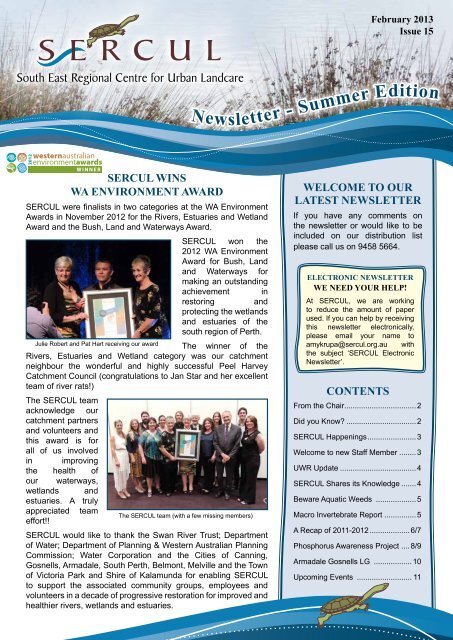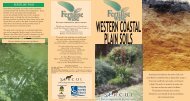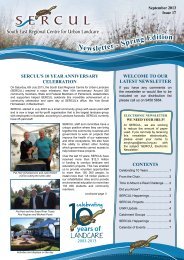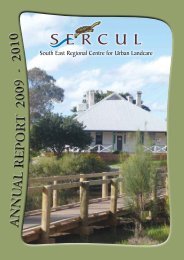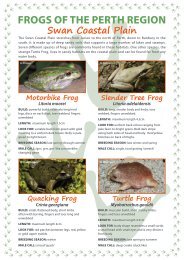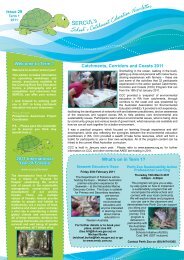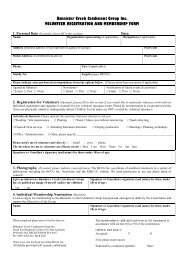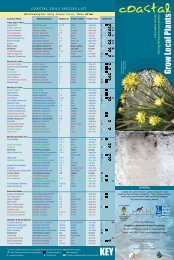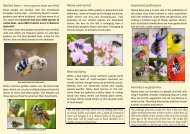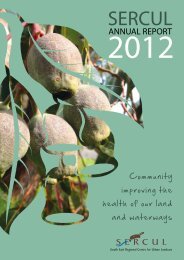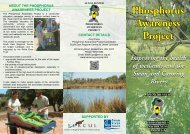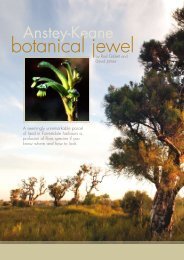Summer 2013 Newsletter - SERCUL
Summer 2013 Newsletter - SERCUL
Summer 2013 Newsletter - SERCUL
Create successful ePaper yourself
Turn your PDF publications into a flip-book with our unique Google optimized e-Paper software.
February <strong>2013</strong><br />
Issue 15<br />
<strong>Newsletter</strong> - <strong>Summer</strong> Edition<br />
<strong>SERCUL</strong> wins<br />
WA Environment Award<br />
<strong>SERCUL</strong> were finalists in two categories at the WA Environment<br />
Awards in November 2012 for the Rivers, Estuaries and Wetland<br />
Award and the Bush, Land and Waterways Award.<br />
<strong>SERCUL</strong> won the<br />
2012 WA Environment<br />
Award for Bush, Land<br />
and Waterways for<br />
making an outstanding<br />
achievement in<br />
restoring and<br />
protecting the wetlands<br />
and estuaries of the<br />
south region of Perth.<br />
Julie Robert and Pat Hart receiving our award<br />
The winner of the<br />
Rivers, Estuaries and Wetland category was our catchment<br />
neighbour the wonderful and highly successful Peel Harvey<br />
Catchment Council (congratulations to Jan Star and her excellent<br />
team of river rats!)<br />
The <strong>SERCUL</strong> team<br />
acknowledge our<br />
catchment partners<br />
and volunteers and<br />
this award is for<br />
all of us involved<br />
in improving<br />
the health of<br />
our waterways,<br />
wetlands and<br />
estuaries. A truly<br />
appreciated team<br />
The <strong>SERCUL</strong> team (with a few missing members)<br />
effort!!<br />
<strong>SERCUL</strong> would like to thank the Swan River Trust; Department<br />
of Water; Department of Planning & Western Australian Planning<br />
Commission; Water Corporation and the Cities of Canning,<br />
Gosnells, Armadale, South Perth, Belmont, Melville and the Town<br />
of Victoria Park and Shire of Kalamunda for enabling <strong>SERCUL</strong><br />
to support the associated community groups, employees and<br />
volunteers in a decade of progressive restoration for improved and<br />
healthier rivers, wetlands and estuaries.<br />
Welcome to our<br />
Latest <strong>Newsletter</strong><br />
If you have any comments on<br />
the newsletter or would like to be<br />
included on our distribution list<br />
please call us on 9458 5664.<br />
Electronic <strong>Newsletter</strong><br />
WE NEED YOUR HELP!<br />
At <strong>SERCUL</strong>, we are working<br />
to reduce the amount of paper<br />
used. If you can help by receiving<br />
this newsletter electronically,<br />
please email your name to<br />
amykrupa@sercul.org.au with<br />
the subject ‘<strong>SERCUL</strong> Electronic<br />
<strong>Newsletter</strong>’.<br />
Contents<br />
From the Chair..................................2<br />
Did you Know..................................2<br />
<strong>SERCUL</strong> Happenings....................... 3<br />
Welcome to new Staff Member......... 3<br />
UWR Update.....................................4<br />
<strong>SERCUL</strong> Shares its Knowledge........ 4<br />
Beware Aquatic Weeds .................... 5<br />
Macro Invertebrate Report ............... 5<br />
A Recap of 2011-2012.................... 6/7<br />
Phosphorus Awareness Project .... 8/9<br />
Armadale Gosnells LG ................... 10<br />
Upcoming Events ........................... 11
From the Chair<br />
2<br />
Did You Know<br />
One of Australia’s worst water weeds<br />
has been discovered in a creek in<br />
Lynwood, prompting an alert from<br />
the Department of Agriculture and<br />
Food to avoid dumping suspect<br />
plants in creeks or drains.<br />
Department research officer Sandy<br />
Lloyd said water hyacinth was<br />
reported at Bannister Creek by a<br />
local natural resource management<br />
group.<br />
It is suspected the weed was dumped<br />
in a stormwater drain or directly into<br />
the creek.<br />
“Water hyacinth is one of the world’s<br />
worst weeds, choking up rivers,<br />
lakes and other waterways,” Ms<br />
Lloyd said.<br />
“It is a declared plant in Western<br />
Australia, prohibited from sale and it<br />
must be destroyed when found.”<br />
“Suspect aquatic weeds can be<br />
reported to the Department’s Pest<br />
and Disease Information Service on<br />
1800 084 881.”<br />
Ms Lloyd said water hyacinth was<br />
recently listed as a Weed of National<br />
Significance.<br />
“If people have unwanted pond<br />
plants or fish, please dispose of<br />
them safely, do not introduce them<br />
to waterways where they could<br />
cause havoc. Something dumped in<br />
a creek or drain could spread many<br />
kilometres. We have already had<br />
problems with pond plants dumped<br />
in the Canning River system,<br />
including hydrocotyl and sagittaria.”<br />
From the Chair<br />
<strong>2013</strong> is a special year for <strong>SERCUL</strong> as we celebrate 10 years since our<br />
inception, having evolved out of the long running Canning Catchment<br />
Coordinating Group. What a fabulous productive journey it has been<br />
for NRM in our sub region. We have cemented strong partnerships<br />
with many Local Governments, State Government Agencies and<br />
learning institutions. We have assisted and established numerous<br />
community groups while at the same time having undertaken many<br />
successful projects. Many of our staff have been with us for most<br />
of our journey including our outstanding CEO Julie Robert, Finance<br />
Manager Sandy Wainwright and Education Manager Amy Krupa who<br />
have been with us from the beginning.<br />
<strong>SERCUL</strong> looks forward to continuing our strong relationships with all<br />
our stakeholders as we head off into this New Year. There will be many<br />
opportunities and challenges we know we will face as we continue on<br />
repairing and managing our precious natural environment for future<br />
generations.<br />
Pat Hart<br />
Chairperson<br />
Chris Ferreira patron of <strong>SERCUL</strong><br />
<strong>SERCUL</strong> is very fortunate to start our<br />
tenth year with the announcement that<br />
Chris Ferreira, an outstanding advocate<br />
for Landcare over many years, has<br />
agreed to be our Patron. We look forward<br />
to a very rewarding association with Chris<br />
over the coming years.<br />
Chris has been a leading exponent of<br />
sustainable land management in WA<br />
for the last 22 years. He specialises<br />
in sustainable, waterwise and energy<br />
efficient gardening, landscaping and landcare. He runs the award<br />
winning Landcare Solutions which specialises in environmental<br />
design, management, education and media.<br />
Chris has a solid background in environmental science and has<br />
emerged as a leading authority on sustainable living in the public<br />
eye with regular roles on 720 ABC Radio and on the ‘ask the expert’<br />
segment of 94.5FM. He currently works in an advisory capacity on a<br />
range of high profile and award winning projects:<br />
• Great Gardens–Chris is co-founder of this award winning program,<br />
which is the largest free community education scheme in Australia.<br />
Great Gardens has been delivering workshops since 2003 and has<br />
reached more than 75,000 people across WA.<br />
• Heavenly Hectares–Chris provides workshops to the rural community<br />
on sustainable land management and the project now features a book<br />
of the same name. Heavenly Hectares has been running since 1993<br />
and has reached over 9,000 hobby farmers.<br />
For more information on Landcare Solutions, visit www.greatgardens.info or<br />
email chris@landcaresolutions.net.au
<strong>SERCUL</strong> Happenings<br />
BECKENHAM OPEN SPACE<br />
As we draw to the end of the season and reflect, the Beckenham Open<br />
Space has had a very successful year in terms of community engagement,<br />
planting, weed control and maintenance of the precinct.<br />
The many volunteer hours contributed helped us in many activities.<br />
These included the construction of the permaculture garden wall and<br />
the module flooring. Our planting activities included two school groups<br />
for the Governor’s Day, and the Sathyai Sai Group who have regularly<br />
planted over the years. Other activities include hand weeding which our<br />
volunteers handled with due diligence!<br />
Thank you to all our volunteers over the year and we wish you all the best<br />
for a successful <strong>2013</strong>.<br />
Beckenham Memorial site progression before and after<br />
Native water lily at <strong>SERCUL</strong><br />
The native water lily Ottelia ovalifolia has been<br />
found in the Yule Brook Wetlands that surround<br />
the <strong>SERCUL</strong> Homestead.<br />
It is an attached, emergent, aquatic perennial herb.<br />
It’s flowers are cream–white with a distinctive red<br />
and yellow centre and flowers during the warmer<br />
months from October to May.<br />
It is found in freshwater pools throughout the<br />
Swan Coastal Plain.<br />
Native water lily<br />
Ottelia ovalifolia<br />
FAREWELL STUART KNOTT<br />
It is with sadness that we advise the passing of Stuart Knott<br />
from the Coastal NRM Group. Stuart was involved with NRM<br />
for many years and was very passionate about the repair and<br />
management of the coastal areas of the metro region. Stuart<br />
was also a man of principle and stood very firm during the<br />
Perth NRM debacle over the past years, something for which<br />
many of us will be forever grateful for. Stuart’s passing is a real<br />
loss for NRM.<br />
Welcome new<br />
staff member<br />
to <strong>SERCUL</strong><br />
Michael Klunzinger has joined<br />
<strong>SERCUL</strong> as an Environmental<br />
Management Planning Officer until<br />
June <strong>2013</strong>. Michael’s role in this<br />
position is to facilitate a review<br />
of the Bannister Creek Reserve<br />
Management Plan (written by Dr.<br />
Judith Fisher in 1999) and work with<br />
community and stakeholders to agree<br />
to a new set of actions in a revised<br />
plan.<br />
Michael has worked in partnership with<br />
<strong>SERCUL</strong> since 2009, during his now<br />
completed PhD study on freshwater<br />
mussels (www.musselwatchwa.<br />
com) and was a member of the<br />
Freshwater Fish Group & Fish Health<br />
Unit (Murdoch University). A key<br />
achievement is the recent success of<br />
the Freshwater Fauna Project, which<br />
he hopes will continue to be a useful<br />
community education tool.<br />
Michael comes to us from the USA<br />
and prior to his PhD, Michael travelled<br />
the world as a shearer. With the aches<br />
and pains behind him, he is keen to roll<br />
up his sleeves and continue to work<br />
towards environmental improvement<br />
and doing what he can for flora and<br />
fauna conservation here in one of<br />
the world’s biodiversity hotspots.<br />
He was also recently appointed as<br />
a member of the WA Threatened<br />
Species Scientific Committee and the<br />
Swan River Trust’s Technical Advisory<br />
Panel. He is happy and proud to<br />
serve the community in his new role<br />
with <strong>SERCUL</strong>.<br />
Welcome to the team Michael!<br />
Michael searching for mussels<br />
3
<strong>SERCUL</strong> Happenings<br />
4<br />
UWR update<br />
At Bannister Creek, after a<br />
fantastic makeover early in 2012<br />
to the UWR section, the creek is<br />
now converted to an attractive<br />
living stream and parkland to<br />
improve water quality and natural<br />
diversity. Revegetation and weed<br />
control of the creek banks and<br />
floodplain are ongoing.<br />
Of the four UWR Bickley Brook<br />
projects, the construction of the<br />
two rain gardens by the City of<br />
Gosnells has been the highlight<br />
of the last couple of months. They<br />
are now fitting the flow meters<br />
and data loggers to start the water<br />
monitoring.<br />
Bannister Creek, near Hybanthus Road<br />
The Southern River UWR<br />
projects involved reshaping and<br />
revegetation of existing basins<br />
at Strawberry, Third and Seville<br />
Roads, as well as Kuhl Park.<br />
However, the largest project is<br />
the Wungong River site. This<br />
project reconnects the Wungong<br />
River with its flood plain through<br />
the removal of the concrete<br />
stormwater pipe from Riverside<br />
Lane and creates a winter<br />
billabong to intercept and filter<br />
stormwater from the residential<br />
area to improve water quality and<br />
enhance biodiversity.<br />
For more details and photos follow<br />
us at our <strong>SERCUL</strong> Facebook<br />
page.<br />
<strong>SERCUL</strong> Shares its knowledge<br />
Between September and November 2012 <strong>SERCUL</strong> staff were busy<br />
sharing their knowledge at several conferences, symposiums and<br />
workshops.<br />
First, Amy Krupa attended the Biennial Australian Association for<br />
Environmental Education Conference in Melbourne from the 30th<br />
September to 3rd October 2012. Amy presented a paper on the<br />
Phosphorus Awareness Project and its successes and challenges<br />
over the last 14 years. Ana Terrazas and Glen Byleveld also attended<br />
a conference in Melbourne, the 15th International Riversymposium,<br />
from the 8th to 11th October 2012. They presented a poster about<br />
the Track and Trace<br />
project in the Kelmscott<br />
industrial area which<br />
involves hanging pads on<br />
drain grates which float<br />
on top of the stormwater<br />
and absorb hydrocarbons<br />
from its surface without<br />
obstructing the flow.<br />
They also presented on<br />
‘Integrating community and government in a rapidly urbanising Perth’,<br />
at the River partnership stream session and finished the conference<br />
by participating in the study tour to the Yarra Catchment, managed by<br />
Melbourne Water.<br />
<strong>SERCUL</strong> was involved as a sponsor and member of the Executive<br />
Committee of the 13th International<br />
Conference Wetland Systems for<br />
Water Pollution Control hosted<br />
and organised by Murdoch<br />
University in collaboration with<br />
IWA and AWA in Perth from the<br />
25th to 29th November 2012. It<br />
was a successful conference with<br />
Wetland Conference tour at<br />
Tom Bateman wetland<br />
Glen at the River Symposium in Melbourne<br />
230 people registered from 45<br />
countries.<br />
<strong>SERCUL</strong> in partnership with the Swan River Trust hosted two of the<br />
field tours which involved a study tour of the Canning River Catchment<br />
including two Urban Waterways Renewal sites, two DNIP sites as well<br />
as the largest constructed wetland south of the river, Tom Bateman.<br />
Julie Robert spoke about the role the community plays in wetland<br />
management along with Rod Hughes, Mike Mouritz and Noel Nannup<br />
at the Public Forum at the City of Canning.<br />
<strong>SERCUL</strong> also had a big presence at the Society for Ecological<br />
Restoration Australasia (SERA) conference held in Perth, from<br />
the 28th to 30th November 2012. <strong>SERCUL</strong>, in partnership with the<br />
Department of Water and Dr Judith Fisher hosted two Symposia:<br />
Aquatic Ecosystems - Restoration Interactions and Living Stream<br />
Restoration.<br />
We thank all those involved whose hard work from presenting papers and<br />
posters, chairing sessions, organising tours and attending made <strong>SERCUL</strong>’s<br />
presence at these events a success.
<strong>SERCUL</strong> Pre-revegetation (macroinvertebrate and herpetofauna) Inventory Surveys 2011<br />
i<br />
<strong>SERCUL</strong> Happenings<br />
BEWARE Aquatic weeds being found<br />
in wetlands<br />
<strong>SERCUL</strong> staff have noticed an increase in invasive aquarium plants<br />
being found in the waterways and wetlands surrounding Perth.<br />
In July 2012, the aquatic weed Eichhornia crassipes (Water hyacinth)<br />
was found in Bannister Creek for the first time, raising alarm for the<br />
local community groups as extensive riverine restoration works have<br />
occurred downstream of this highly invasive species. Refer to the<br />
article on page 2 for more information.<br />
Amazon frogbit<br />
Limnobium laevigatum<br />
In January <strong>2013</strong>, a<br />
new weed, Limnobium<br />
laevigatum (commonly<br />
known as Amazon frogbit<br />
or South American<br />
spongeplant) was found in<br />
the Liege Street Wetlands<br />
in Cannington. The arrival<br />
of this plant into a Perth<br />
wetland/waterway has<br />
sparked serious concern<br />
as to how these aquarium<br />
Amazon frogbit in drain at Liege Street<br />
plants are increasingly<br />
appearing in Perth’s natural waterway systems.<br />
Many of these potentially serious invasive weeds are sold as aquarium<br />
and pond plants and it appears that they may be being disposed of<br />
by residents, either directly into our waterways, or indirectly through<br />
the storm water drainage system, which leads to natural wetlands and<br />
waterways.<br />
These weeds have the potential to overtake rivers, creeks and<br />
wetlands and cause detrimental effects to existing wildlife and flora.<br />
The potential cost of such<br />
an invasion by this new<br />
weed is significant and a<br />
substantial effort is now<br />
required to eradicate this<br />
new invasive.<br />
Community and all<br />
waterway workers need<br />
to be extra vigilant<br />
in inspecting nearby<br />
waterways and wetlands<br />
for any signs of this new<br />
invasive weed.<br />
Amazon frogbit that was removed from the<br />
drain at Liege Street<br />
Macro<br />
InvertEbrate<br />
Report<br />
<strong>SERCUL</strong> have collated and<br />
printed a very extensive report<br />
on the macroinvertebrate and<br />
herpetofauna found in the Canning<br />
Catchment Urban Waterway<br />
Renewal restoration sites.<br />
The report contains more than<br />
400 high quality colour plate<br />
photographs of the fauna found<br />
during the surveys conducted by Mr<br />
David Knowles.<br />
David uses a unique<br />
survey technique<br />
that reduces<br />
environmental impact<br />
by recording all<br />
specimens collected<br />
using high tech<br />
digital photography<br />
then returning the<br />
specimen live to the<br />
site it is taken from<br />
within 12 hours.<br />
Herpetofauna &<br />
of the Canning Catchment<br />
Macroinvertebrate<br />
Pre-revegetation Inventory Survey<br />
October — November 2011<br />
SpineleSS WonderS<br />
TerresTrial inverTebraTes.<br />
American Monarch Nymwing<br />
Danaus plexippus<br />
<strong>SERCUL</strong> have published the<br />
document as we consider that the<br />
information contained within it is<br />
highly valuable to the environmental<br />
community. The document is not<br />
intended for use as a field guide.<br />
The document is available from<br />
<strong>SERCUL</strong> at cost of print for $50<br />
(postage extra).<br />
5
A Recap of 2011-2012<br />
Facts and Figures<br />
Over the 2011–2012 financial year <strong>SERCUL</strong> received<br />
more than $5 million income and incurred expenses<br />
totalling just over $4 million.<br />
These figures have considerably increased from<br />
previous years. The Urban Waterways Renewal (UWR)<br />
Projects account for a large proportion of the vast<br />
increase in turnover. However, since inception, without<br />
the inclusion of the UWR projects, <strong>SERCUL</strong> has<br />
achieved a steady 10–20% annual increase in turnover.<br />
It is expected that the business turnover will return<br />
to a more steady business growth continuum after<br />
completion of the next financial year.<br />
Although new funding for the extension of the renewal<br />
of urban drains has not yet been achieved in all project<br />
sites, <strong>SERCUL</strong> staff and the committee have worked<br />
very hard to ensure that the intellectual knowledge<br />
and staff development that has occurred during this<br />
extensive increase in output is not lost and new projects<br />
have been achieved external to the UWR program that<br />
should sustain the current <strong>SERCUL</strong> staffing levels for<br />
<strong>2013</strong>.<br />
GOVERNOR’S VISIT<br />
We were fortunate to have some special guests at our<br />
Schools Tree Day planting event at the Beckenham<br />
Open Space, including the Governor of WA, the<br />
Honourable Malcolm McCusker; the Gosnells Mayor,<br />
Mr Dave Griffiths; the Minister for Planning, Mr John<br />
Day; and the Director of Bowra & O’Dea, Mr Joe<br />
O’Dea. Their attendance was warmly received by<br />
school children from Beckenham Primary School and<br />
Cannington Community Education Support Centre.<br />
A total of 4000 plants were planted with 757 volunteer<br />
hours contributed.<br />
Planning Minister John Day, Gosnells<br />
Mayor and Malcolm McCusker<br />
Figures for 2011-2012<br />
$1 608 597<br />
Australian Government Funding<br />
$783 302<br />
State Government Funding<br />
$165 275<br />
Local Government Funding<br />
$358 624<br />
Other Project Sponsors<br />
>18 879 hrs<br />
Volunteer Contribution<br />
>$547 302<br />
Total Value of Volunteering<br />
(Value of Volunteering = $28.99/hr)<br />
316 163<br />
Plants Installed<br />
>13 917<br />
People Received Education,<br />
via Direct Information or<br />
On-ground Contact<br />
Chevron – Conservation Volunteers<br />
Australia partnership<br />
In 2012 <strong>SERCUL</strong> was provided with<br />
15 weeks of Conservation Volunteers<br />
Australia (CVA) time to help in<br />
river restoration projects. Through<br />
the year we had 703 volunteers<br />
contributing 3745 volunteer hours.<br />
Numerous groups were allocated<br />
CVA time including: Canning River<br />
Regional Park Volunteers; Wilson Wetland Action Group; FO Brixton Street<br />
Wetland; Two Rivers Catchment Group; Bannister Creek Catchment<br />
Group; Armadale Gosnells Landcare Group; and numerous <strong>SERCUL</strong><br />
projects including the Urban Waterways Renewal projects.<br />
Canning River Regional Park Post Fire Project<br />
This project is progressing very well with strong recruitment<br />
of native species from the seed bank made possible by an<br />
intensive weed management regime.<br />
108 Waterway Sites Sampled<br />
447 Samples Analysed in the Perth Region<br />
6<br />
Transect monitoring, BEFORE<br />
Transect monitoring, AFTER
Urban Waterways Renewal<br />
Project (UWR)<br />
The project works in 2012 have included planting, weeding,<br />
rubbish removal, site redesign, major construction works,<br />
bushland and wetland restoration and ongoing monitoring.<br />
UWR achievements over 2012:<br />
• On-site visit by Senator Don Farrell<br />
• More than 20 community and corporate planting days<br />
have been held<br />
• Facebook photo albums have been created for each<br />
catchment to showcase the progress of each project<br />
• Four media articles in local community newspapers<br />
• Site signage is being installed<br />
• Nine riffle structures have been constructed and major<br />
river restoration has been implemented<br />
• Total plants planted = 119 694<br />
• Total volunteers = 616<br />
• Total volunteer hours = 2583.5<br />
• (Value $74 921.50)<br />
Monitoring and<br />
Research Projects<br />
Monitoring and research played a big<br />
part throughout 2012 with <strong>SERCUL</strong><br />
undertaking several projects:<br />
• Aquatic macro invertebrates survey<br />
• Freshwater mussels survey<br />
• Bird survey<br />
• Landscape change photo monitoring<br />
• Terrestrial macro invertebrate survey<br />
• Track and trace hydrocarbon survey<br />
• Vegetation monitoring<br />
For further information and/or copies of any<br />
of these surveys please contact <strong>SERCUL</strong>.<br />
Julie Robert with Senator Don Farrell<br />
Bushforever site 456: Tom Bateman – Nicholson Rd Bushland<br />
The Bannister Creek Catchment Group (BCCG) have received funding for the Nicholson Rd Bushland site and Tom<br />
Bateman Wetlands. Both sites form the Bushforever site 456 with weed control being the major focus of the projects.<br />
Two endangered plant communities exist in the site and three significant plant types have been identified making this an<br />
area of high conservation value. Exotic grass invasion control and revegetation of the area leading from the Roe Hwy<br />
wildlife corridor have been the priorities for this site.<br />
Seed collection activities at Nicholson Road Bushland in 2011 have enabled the BCCG to plant provenance stock at the<br />
site forming an important naturally vegetated corridor from the Roe Hwy wildlife corridor providing improved connectivity<br />
with the Tom Bateman wetlands.<br />
A total of 5921 plants were planted in 2012 with the volunteer contribution over 349 hours.<br />
Ditte Strebel from<br />
<strong>SERCUL</strong> seed<br />
collecting at Nicholson<br />
Rd Bushland<br />
The South East Regional Centre for Urban Landcare<br />
Inc. Committee and Staff sincerely thank all the<br />
Community Groups, Non Government Organisations,<br />
Volunteers, Local Government Authorities, State and<br />
Australian Government Departments and Private<br />
Business project partners for your contribution towards<br />
the care and protection of the Natural Resources of the<br />
Swan Region during the 2011–2012 year.<br />
Tom Bateman<br />
Wetland in 2011<br />
7
Printed on 100% recycled paper.<br />
ALGAE BUSTER<br />
PHOSPHORUS<br />
AWARENESS<br />
PROJECT<br />
Caring for the Swan Canning Riverpark<br />
Phosphorus Awareness Project<br />
LOCAL<br />
GOVERNMENT<br />
NutRient report<br />
The Phosphorus Awareness<br />
Project has been surveying the<br />
30 Local Government Authorities<br />
(LGA’s) from the Swan-Canning<br />
Catchment for eleven years<br />
(previously the nine LGA’s of the<br />
Canning Catchment had been<br />
surveyed) on their nutrient use.<br />
LGA’s are responsible for nutrient<br />
use on turfed areas, reserves and<br />
in local planning decisions and<br />
thus have the<br />
opportunity<br />
to lead the<br />
community<br />
by setting<br />
examples in<br />
best practice.<br />
Annual Nutrient Survey for<br />
Local Government Authorities<br />
Results 2012<br />
Twenty of the<br />
thirty LGA’s<br />
responded<br />
An initiative of the South East Regional Centre for Urban Landcare’s<br />
Phosphorus Awareness Project<br />
This report has been prepared for the Phosphorus Awareness Project,<br />
to South East Regional Centre for Urban Landcare, 2012.<br />
s u r v e y .<br />
Eighteen of<br />
the twenty LGA’s that responded<br />
had participated in the 2011 survey.<br />
The results of the survey indicated<br />
that LGA’s in the Swan-Canning<br />
Catchment are conducting varying<br />
degrees of Best Management<br />
Practices (BMP’s) in nutrient<br />
management. Overall the<br />
majority of LGA’s conducted a<br />
high level of BMP’s in the areas<br />
of nutrient monitoring, turf type,<br />
nutrient management and nutrient<br />
education. A medium level of<br />
BMP’s were achieved in the areas<br />
of fertiliser applications, water<br />
quality monitoring, development<br />
control and waste water systems.<br />
Compared to the 2011 survey<br />
overall there has been a moderate<br />
increase in the use of BMP’s. The<br />
full report can be downloaded from<br />
www.sercul.org.au/pap.html or if<br />
you would like a hard copy please<br />
email amykrupa@sercul.org.au.<br />
For further information please contact Amy Krupa on 9458 5664 or email amykrupa@sercul.org.au<br />
How the Phosphorus Awareness<br />
Project Began<br />
The Phosphorus Awareness Project<br />
(PAP), formally known as the Phosphorus<br />
Action Group (PAG), was formed in<br />
October 1998 as a sub group of the<br />
Canning Catchment Coordinating Group,<br />
now <strong>SERCUL</strong>.<br />
High levels of phosphorus and nitrogen<br />
present in the Swan and Canning River<br />
systems and wetlands are promoting<br />
the growth of nuisance algae, especially<br />
in the middle to lower reaches of the<br />
Canning and the middle reaches of the<br />
Swan. Algae use excess phosphorus<br />
and nitrogen to grow and multiply rapidly to large numbers, thriving<br />
when the weather is warm and sunny and the water flow is slow.<br />
Phosphorus and nitrogen, essential plant and animal nutrients naturally<br />
present in our waterways and soils in very low concentrations, are<br />
readily dissolved in water and easily pass through the food chain.<br />
Whilst low levels sustain life, excessive amounts of nutrients cause<br />
serious water quality problems.<br />
The PAP is an education<br />
campaign that informs the<br />
general community about the<br />
impact of too many nutrients in<br />
the Swan and Canning River<br />
systems and wetlands and how<br />
to reduce those levels. The<br />
project aims to see a decrease in<br />
nutrient loads and algal blooms<br />
through changes in community<br />
and industry behaviour and practices resulting in biodiverse and<br />
sustainable rivers and wetlands throughout Perth.<br />
The project aims to reduce the amount of nutrients people contribute<br />
to waterways through stormwater drains, groundwater and catchment<br />
run-off by:<br />
•<br />
Making the connections for people between their backyards, the<br />
stormwater drainage and groundwater systems and water bodies<br />
such as the Swan and Canning Rivers;<br />
•<br />
Promoting appropriate fertiliser practises for the soils of the<br />
region–Fertilise Wise. The lack of general awareness of high<br />
nutrient levels in fertilisers is a target for the campaign;<br />
Educating householders to use P-free (NP) detergents, particularly<br />
•<br />
in unsewered areas of the catchment, and to consider the<br />
contribution of pet faeces to nutrient loads in the catchment as<br />
well as bread fed to water birds; and<br />
•<br />
Targeting the community, schools, local government and industry<br />
to decrease their nutrient outputs through education.<br />
The Phosphorus Awareness Project is managed by Project Coordinator, Amy<br />
Krupa, is hosted by <strong>SERCUL</strong> and is supported by the Swan River Trust.<br />
8
Phosphorus Awareness Project<br />
LAKE RICHMOND NUTRIENT WORKSHOPS<br />
<strong>SERCUL</strong> and the PAP were<br />
contracted by the City of<br />
Rockingham in the latter half<br />
of 2012 to run four nutrient<br />
information sessions for<br />
the local community about<br />
protecting Lake Richmond.<br />
Lake Richmond is located<br />
on Safety Bay Road in<br />
Rockingham, across the<br />
road from the Naragebup<br />
Environment Centre, and has a catchment area that covers most of<br />
Rockingham’s suburbs.<br />
Lake Richmond is a special wetland with a number of factors making it<br />
unique including it’s:<br />
* size which is approximately 1000m long and 600m wide and covers an<br />
area of approximately 40 hectares<br />
* depth of between 10 and 15m deep in places<br />
* a perennial freshwater lake (unusual for the area)<br />
* alkaline (pH of 8.3 to 9.3)<br />
* rich in calcium. It is believed the calcium comes from the groundwater<br />
which has passed through the calcium-rich dunes that surround the lake.<br />
Micro-organisms use this calcium to create thrombolites.<br />
Thrombolites are living rocks<br />
built by micro-organisms.<br />
As these micro-organisms<br />
photosynthesise, thrombolites<br />
are formed. During the process<br />
of photosynthesis, the microorganisms<br />
separate calcium<br />
carbonate from the lime-enriched<br />
water of Lake Richmond to form<br />
a unique rock-like structure. The<br />
three hectares of thrombolites at<br />
Lake Richmond have adapted over time to freshwater conditions and rely<br />
on sunlight and fresh water rich in carbonates for growth and survival.<br />
They are a critically endangered Threatened Ecological Community<br />
(TEC). The Sedgelands that fringe Lake Richmond are also a critically<br />
endangered TEC.<br />
Unfortunately increasing nutrient levels and algal blooms, feral fish and<br />
yabbies and changes in water quantity are all impacting on the lake and<br />
the thrombolites. The information sessions<br />
provided ideas for people on how to use<br />
less nutrients in their own backyards.<br />
Many of the participants were also keen to<br />
be involved in a Friends of Group that will<br />
now be established to look after this very<br />
important place.<br />
Catchments,<br />
Corridors and<br />
Coasts!<br />
Snorkelling in the ocean, walking<br />
in the bush, getting up close and<br />
personal with native fauna, sharing<br />
experiences with like-minded people<br />
– these are just some of the activities<br />
that 23 participants experienced<br />
on the action packed Catchments,<br />
Corridors and Coasts (CCC)<br />
Program that ran from the 16th-18th<br />
January <strong>2013</strong>.<br />
CCC provided a ‘snapshot’ of<br />
environmental education in WA<br />
from catchments, through corridors<br />
to the coast and was presented<br />
by the Australian Association for<br />
Environmental Education WA<br />
Chapter. <strong>SERCUL</strong> helped to coorganise<br />
the program and presented<br />
during the water focused afternoon.<br />
The program provided a rich<br />
experience, facilitated the<br />
development of networks with<br />
and between practitioners, and an<br />
awareness of the resources and<br />
support across WA to help address<br />
core environmental and sustainability<br />
issues. Participants learnt about<br />
environmental issues, what is being<br />
achieved by community groups and<br />
various levels of government, what<br />
resources are available and how<br />
we can all work together for a better<br />
environment.<br />
More information about CCC is<br />
available at www.aaeewa.org.au.<br />
9
SCALE<br />
Armadale Gosnells Landcare Group<br />
Farewell to Dan<br />
Dan Walker finished with the<br />
Armadale Gosnells Landcare<br />
Group (AGLG) at the end of 2012<br />
to take up the position of Bush<br />
Crew Supervisor with the City of<br />
Armadale.<br />
Dan had been in the role of River<br />
Restoration Officer for AGLG<br />
since June 2011 and brought<br />
a high level of knowledge,<br />
enthusiasm and professionalism<br />
to the group. We wish Dan well<br />
and look forward to working with<br />
him in his new role.<br />
AGLG will be contracting a<br />
person for the remaining six<br />
months of the River Restoration<br />
Officer contract to cover the <strong>2013</strong><br />
planting season.<br />
PALOMINO DAMP LAND PROJECT<br />
The Armadale Gosnells Landcare Group (AGLG) have received<br />
funding through the State NRM community grants programme for<br />
an exciting new project on the Wungong River in the Palomino<br />
Reserve, Armadale.<br />
AGLG will be working with the City of Armadale and the Palomino<br />
Reserve Catchment Group to create a seasonal damp land on the<br />
bank of the Wungong River. Once a series of seasonal wetlands<br />
existed along the Wungong River, but have since been highly<br />
modified through development. Significant works are already under<br />
way along the Wungong River to restore wetland areas through the<br />
Urban Waterways Renewal Project. This project contributes to a<br />
chain of both natural and man made wetlands along the Wungong<br />
River.<br />
Following an<br />
archaeological<br />
survey, earthworks<br />
will be done to<br />
create a low damp<br />
area which water<br />
will flow through<br />
during winter. The<br />
damp land will be<br />
planted with local<br />
native seedlings,<br />
adding to the<br />
Wungong River, McNeill Road (upstream) 2003<br />
existing restoration<br />
work carried out at the reserve since the late 1990’s. The purpose<br />
of the damp land is to improve water quality though the uptake of<br />
nutrients by native plants. The area will also provide habitat for<br />
native aquatic and terrestrial fauna.<br />
Dan at the <strong>SERCUL</strong> Team Building<br />
training session in 2012<br />
AGLG’s Landcare Coordinator,<br />
Les Judd, will be staying for<br />
another 12 months as Crystal<br />
Gillam has extended her<br />
maternity leave for another year.<br />
IN<br />
OUT<br />
Cross Section<br />
East<br />
TOTAL AREA OF WORKS 200m²<br />
AREA OF BASE 625m²<br />
MAXIMUM DEPTH 400mm<br />
AVERAGE BATTER SLOPE 1:30<br />
APPROXIMATELY 700m³ TO BE EXCAVATED<br />
N<br />
1 : 450<br />
WUNGONG RIVER<br />
PROPOSED SHALLOW SEASONAL DAMP ZONE PROJECT - CROSS SECTION<br />
10
Upcoming Events<br />
Date and Time Event Group Contact<br />
Sunday 17 Feb<br />
8:30am - 10:30am<br />
Sunday 17 Feb<br />
9am - 12 noon<br />
Monday 18 and<br />
25 Feb<br />
8:30am - 11am<br />
Sunday 3 Mar<br />
4:30pm - 7:30pm<br />
WWAG Work Morning<br />
Volunteers welcome.<br />
Meeting place: Contact Russell for details<br />
Dieback Treatment Field Day<br />
All volunteers are very welcome. Morning tea<br />
is provided.<br />
Go to www.roleybushcare.com.au for meeting<br />
places details.<br />
FoMCL Work Morning<br />
SALP sites check/weed.<br />
Meet Eudoria St car park, Gosnells or go to<br />
site (phone the night before if not sure)<br />
FoMCL Cockatoo Watch<br />
Meet Eudoria St car park, Gosnells<br />
Wilson Wetlands Action<br />
Group<br />
Roleybushcare<br />
Friends of Mary Carroll<br />
Lake<br />
Friends of Mary Carroll<br />
Lake<br />
Russell 9258 7301 or<br />
email wilsonwetland@<br />
gmail.com<br />
Roleybushcare<br />
0408 886 474<br />
Unice 9398 7126<br />
Unice 9398 7126<br />
Thursday 7 Mar<br />
6:30pm - 8:30pm<br />
An Evening with Tim Flannery & Great<br />
Gardens at Perth Zoo<br />
Join Australian of the Year, Tim Flannery, and<br />
the Great Gardens Team on an inspirational<br />
‘sight and sound’ adventure exploring the joy<br />
of creating vibrant communities to meet the<br />
challenges of the 21st Century.<br />
$49 ($39 concession)<br />
Great Gardens<br />
www.extension.<br />
uwa.edu.au/course/<br />
CEVG001<br />
or<br />
6488 2433<br />
Sunday 10 Mar<br />
8:30am - 10:30am<br />
WWAG Work Morning<br />
Volunteers welcome.<br />
Meeting place: Contact Russell for details<br />
Wilson Wetlands Action<br />
Group<br />
Russell 9258 7301 or<br />
email wilsonwetland@<br />
gmail.com<br />
Saturday 16 Mar<br />
8:30am<br />
CRRPV Work Day<br />
Weeding. Anyone with time to spare<br />
would be welcomed.<br />
Canning River Regional<br />
Park Volunteers<br />
Jo 9458 3669<br />
Please see the <strong>SERCUL</strong> website calendar for a more up to date listing of current events and more contact details:<br />
www.sercul.org.au/events.html<br />
Over $4000<br />
in prizes to<br />
be won<br />
Paul Smyth, Munster<br />
Nicholas Woods, Dianella<br />
River Guardians Photography Competition<br />
The Swan River Trust and Community Newspaper Group are asking amateur photographers to<br />
capture their favourite places, people and wildlife of Perth’s rivers for entry into the River Guardians’<br />
3rd annual photography competition.<br />
There are more than $4000 worth of great prizes to be won including digital cameras from Camera<br />
Electronic, fabulous Finn Kayaks, Captain Cook Cruises and Scitech family passes, across open and<br />
kid’s categories.<br />
Community Newspaper Group will run selections of photos across their publications and on a public<br />
online gallery. The public can also vote online or at the Autumn River Festival <strong>2013</strong> for the People’s<br />
Choice award.<br />
The photography competition will focus on Life above and below the Swan Canning Riverpark and is<br />
open to all ages from 3 January <strong>2013</strong>. Submissions close 8 March <strong>2013</strong>.<br />
For more information and to submit your entry, visit www.riverguardians.com<br />
Carol Seidel, Bassendean<br />
11
<strong>SERCUL</strong> Executive Committee:<br />
CEO - Julie Robert<br />
Chairperson - Pat Hart<br />
Deputy Chair - Marc Lane<br />
Treasurer - Cam Clay<br />
Secretary - Yvonne Ward<br />
Executive Member - Brian Aldrich<br />
Contact us at:<br />
69 Horley Road,<br />
Beckenham WA 6107<br />
Phone: 9458 5664<br />
Fax: 9458 5661<br />
www.sercul.org.au<br />
Please see our website for all other staff details.<br />
www.sercul.org.au/staff.html<br />
If undeliverable, please return to:<br />
<strong>SERCUL</strong><br />
69 Horley Road<br />
Beckenham WA 6107<br />
POSTAGE<br />
PAID<br />
AUSTRALIA<br />
The South East Regional Centre for Urban Landcare<br />
wishes to thank our main sponsors.<br />
Caring for the Swan Canning Riverpark<br />
This newsletter is printed on 100% recycled paper.


